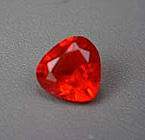

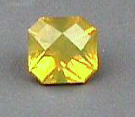
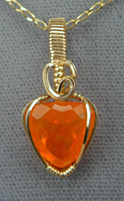
There are so many different names in use for this type of opal: fire opal, jelly opal, crystal opal, cherry opal, girasol, etc. In my opinion, therefore, the best general term for this sort of transparent opal with body color ranging from colorless through yellow to orange to deep red and usually without play of color, is Mexican opal. Even though some pieces originate from other locales such as the USA and Brazil. This terminology helps prevent confusion from the term "fire" which is often used to mean "play of color". Mexican opal that does have play of color is in its own small sub-category, and is properly referred to as "precious Mexican opal".
All opals are hydrated silicates usually containing from 3 - 10% water; but stones from a few sources (notably Virgin Valley, Nevada) can be as high as 20% in water content. If play of color is present, its source is the same in Mexican opal as for the precious white and black opals. Namely, diffraction and interference of light rays which travel through the spaces between the tightly packed silica spheres of which it is made. Some pieces show their color play in reflected light (more common) and some, only in transmitted light. These latter stones, called "contra-luz" are quite rare and desirable.
Facetors appreciate Mexican opal's ready availability in nice sized pieces, its reasonable price, and its wonderful range of highly saturated colors. Only the most transparent pieces lack the phenomenon of "opalescence", which is a slightly to moderately strong milky haze within the stone's interior, similar to that seen in rose quartz. Much has been said about this gem's tendency to craze, that is, to develop fine cracks due to dehydration, but the vast majority of the pieces on the market are stable. Reputable rough dealers screen out the unstable pieces, before sale, by subjecting them to prolonged high temperature and low humidity conditions.
Naturally, as with all types of opal, stones are somewhat fragile, and not well suited for use in rings meant for hard everyday wear or in bracelets or cufflinks. Likewise, strong chemicals, ultrasonic vibrations, and abrupt dramatic temperature changes can cause damage. In earrings, pendants, tie pins, brooches and special occasion rings and with reasonable care, it does very well.
Cleaning with a soft brush and warm soapy water is safe and effective. It is not advisable, in fact, it is likely to be harmful, to store opals in mineral oil or or glycerin and this practice will not prevent crazing. Storage in water, although safe, has no protective benefit. It is wise, however, to store the stones and jewelry items in their own separate compartments to prevent scratching from harder gems and metals.





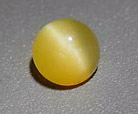
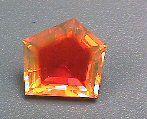
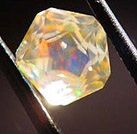
The most desirable pieces are nearly completely transparent and, when colored, show a strong, highly saturated hue. Most reds in this variety are tinged with various degrees of orange, so pure, spectral red pieces are exceedingly rare and therefore higher priced. Play of color enhances the value of any stone dramatically. Cat'seyes and bi-colored stones also sell at a premium.
Mexican opal commands its highest prices in Germany and in Japan where many of the Mexican stones are exported. Here in the US, it remains an excellent bargain, even in larger, custom cut pieces of finest color. Enhancements such as heating, filling or irradiation are at present unknown in this variety.